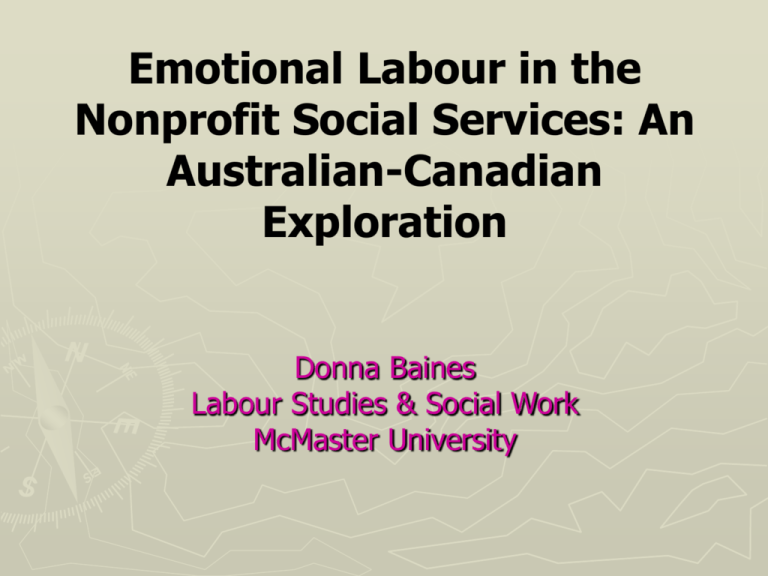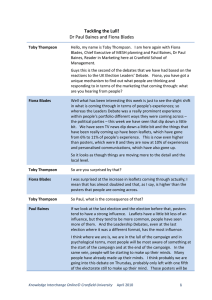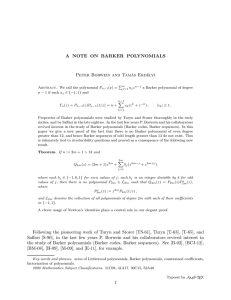Emotional Labour in the Nonprofit Social Services: An Australian
advertisement

Emotional Labour in the Nonprofit Social Services: An Australian-Canadian Exploration Donna Baines Labour Studies & Social Work McMaster University Emotional labour ►Arlie Hochschild (1983) Used to control & speed up service interactions ►Oppressive in most service work (Bolton & Boyd, 2005; Taylor & Tyler, 2000; Leidner, 1999; ) ►Source of meaning in care work (Henderson, 2001; Boyd, 2000; Shuler and Sypher, 2000) “My best experiences happened when clients came back to show me that they had done well, and to maybe laugh and cry about what they’d been through and what we’d done together. They usually try to thank me for being someone who cared about them and took the time to get to know them and really listen. I tell them I don’t want thanks, I have all the thanks I need in just seeing them do so well.” Masculinised Model of Emotional Labour (Lewis, 2005; Bolton, 2005, Maconachie, 2005; Guy, Newman and Mastracci, 2008) ►prescriptive- professional ► NPM = tightly quantified, standardized emotion management Managing your own and other people’s disappointment ► When you deal with other people’s emotional health and dreams all day, it is a very intimate thing you carry around with you, a very intimate bunch of information and expectations. ► Not being able to meet these expectations, let alone your own, is probably one of the most stressful things around. It gets you at an intimate level. Feminized Model of Emotional Labour ► philanthropic-gift model ► open-ended, unscripted, relationship based ► resistance uses pre- NPM, more participatory processes of emotional connection and mutual participation Resistance ► “getting back and getting by” (Nichols & Armstrong, 1976) ► minor infractions of the rules ► open advocacy for change (Burawoy, 1979; Friedman, 1977; LeeTreweek,1997) ► Social Service workers tend to identify with agency mission ► Target gov’t & society, not just employers ► Self exploit as resistance (Baines, 2007, 2004; Smith, 2007) “Most of us are here because we want to work with people in not just in a way that makes a difference, but in a different way. We don’t want to just fill in reports and push paper … We want to work in a way that empowers people and challenges systems that harm people. We want to organize with the community to take control back, not just put band aids on a few of the more obvious victims.” Nonprofit Social Services ►Outside of market and government ►Provides range of services a ► Growing convergence with market, gov’t & voluntary sector New Public Mgmt & Performance Measures Standardizes, Speeds Up Removes Discretion, Activism & Collective Forums To this point: ► Social service workers identify with mission and social justice; NPM work organization removes/limits these aspects ► Workers find workplace meaning in relationships with clients, communities and each other (emotional labour) ► Workers self exploit as resistance What do they do to resist? WITHIN AND OUTSIDE OF PAID WORK ► ► encourage . ► ► ► ► ► ► ► ► clients to advocate for themselves even when it involved risk to the worker bend rules look for ways to get clients all they are entitled to and more do unpaid, volunteer work in their own agencies and others organize service user groups build coalitions provide new services for free use their unions as vehicles for social justice (including: ending the war in Iraq, campaign for an end to queer bashing, demanding care for homeless people, challenging funding cuts and opposing sexism, racism and homophobia, working to end poverty Righting the balance between work and mission ►Doing things they can no longer do on the job (or never could) ► Regaining autonomy, control, constructing their own meanings ►Target their employers as well as larger uncaring society Convergence v. Particularity ► Managerial models in ► Resistance is unique to private and nonprofit logics and ideology of sectors the sector (Evans and Shields, 2002; Considine, 2002; Baines, 2004, 2006; Cunningham,2008) To care ► To participate with others (collectivity) ► To create and sustain relationships ► To make social justice ► To undertake unpaid work when they choose ► To push the boundaries of social unions ► Resistance ► Is replete with emotional labour because workers want it that way ► More than a feminized gift-model ► A gift-solidarity model Reciprocity Mutual participation










